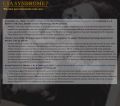Our research reviews elsewhere have often detailed how selective sampling (criminal, legal, therapeutic, self-defined victimhood) is used to identify symptoms first and then construct a syndrome with set characteristics (pedophilia, child sexual abuse). The syndrome is then erroneously generalized to the wider population of individuals experiencing a chronophilia or sex with an adult as a minor or child. Here we put into focus these methodological and conceptual flaws.
CSA Syndrome
Even when unrepresentatively sampled, children involved in intergenerational sexual relationships do not show a set pattern of reactions. In addition to this, certain types of reactions have been correlated with social factors.
- Constantine, L.L., (1981). "The effects of early sexual experiences: A review and synthesis of research," in Constantine, L.L. & Martinson, F.M. (eds.), Children and Sex: New Findings, New Perspectives.
- MHAMIC: "The author concludes that there is no set of reactions that is a single inevitable outcome of adult-child sexual interaction. More negative outcomes are associated with violence or coercion, tense situations, sex-negative attitudes, sexual ignorance, and unsupportive or judgmental adult reactions. The amount of anxiety and guilt that the child experiences depends on two main characteristics of the interaction. These factors are of overwhelming importance in immediate and long-term effects."
- Finkelhor, David (1990). "Early and long-term effects of child sexual abuse: An update," Professional Psychology: Research and Practice, 21(5), pp. 325-330.
- "Another attempt to consider the impact of sexual abuse has been the formulation of a specific sexually-abused-child disorder (Corwin, 1988). This effort has evolved in response to the need many clinicians perceive to have a diagnostic category in which to place sexually abused children. However, this approach has not caught on because it has proved so difficult to define a set of symptoms that clearly delineates sexually abused children. As we have pointed out, some victims appear to be asymptomatic in the immediate wake of abuse. Perhaps more important, victims manifest such a large variety of symptoms that there is no single set of symptoms that can be considered characteristic. The sexualized behavior that many clinicians think is so much the hallmark of the child who has been sexually abused occurs in only 7% of all victims according to the evaluations of 369 children by Conte and Schuerman (1987). The attempts to define a single sexually abused child syndrome are unlikely to meet with future success and acceptance."
- Kendall-Tacket, K. A., Williams, L. M., & Finkelhor, D. (1993). "Impact of Sexual Abuse on Children: A Review and Synthesis of Recent Empirical Studies," Psychological Bulletin, 113(1), 164-180.
- "The findings suggest the absence of any specific syndrome in children who have been sexually abused and no single traumatizing process. [...] The range of symptoms, the lack of a single predominant symptom pattern, and the absence of symptoms in so many victims clearly suggest that diagnosis is complex. Because the effects of abuse can manifest themselves in too many ways, symptoms cannot be easily used, without other evidence, to confirm the presence of sexual abuse. Yet the absence of symptoms certainly cannot be used to rule out sexual abuse. There are too many sexually abused children who are apparently asymptomatic."
Tendency to disclose
Disclosure figures and the reasons for not disclosing shine a light on the positive and indifferent nature of the many experiences which can not be sampled via therapeutic/systemic referrals.
- Lahtinen, H., et al., (2018). "Children's disclosures of sexual abuse in a population-based sample," Child abuse and Neglect, Feb 2018; 76: 84-94.
- "The present study aimed to explore the overall CSA disclosure rate and factors associated with disclosing to adults in a large population-based sample. A representative sample of 11,364 sixth and ninth graders participated in the Finnish Child Victim Survey concerning experiences of violence, including CSA. CSA was defined as having sexual experiences with a person at least five years older at the time of the experience. Within this sample, the CSA prevalence was 2.4%. Children reporting CSA experiences also answered questions regarding disclosure, the disclosure recipient, and potential reasons for not disclosing. The results indicate that most of the children (80%) had disclosed to someone, usually a friend (48%). However, only 26% had disclosed to adults, and even fewer had reported their experiences to authorities (12%). The most common reason for non-disclosing was that the experience was not considered serious enough for reporting (41%), and half of the children having CSA experiences did not self-label their experiences as sexual abuse. Relatively few children reported lacking the courage to disclose (14%)."
Excerpt Graphic
This graphic may be useful if you wish to reproduce some of our sources without being character limited.

